TAJ MAHAL
Table of Contents
INTRODUCTION
TAJ MAHAL means the crown of the palace; Initially, they called it Rauza only, which means mausoleum. Interestingly, it is a symbol of love, a Masterpiece of human arts, a passionate tribute of a King to her Queen for the whole world. Above all, The beauty of the monument tells us the bond between the two souls of Shahjahan and Mumtaz.
Emperor Shahjahan gave us a most beautiful definition of love in the form of the Taj Mahal. Lovers from every country of this world come here to visit this beautiful structure. Indeed, King and Queen died; they left their love story for us. Contrarily, love never dies; the Taj Mahal made their love immortal.
Moreover, whoever comes here, immerse himself/herself entirely in the beauty. When we see the Taj Mahal, It seems, The King and Queen are hugging each other, Clad in white. On the other side, the river Yamuna dances when the Taj Mahal reflects on its water.
WHAT TO SEE IN TAJ MAHAL
As a monument, the Taj Mahal seems one, but there are many places to watch inside. I will narrate to you all the details about the Taj Mahal. Let us start to learn.
ENTRANCES
There are three entrances to go the monument. Let us know what the difference between them is.
EAST GATE: This gate is near the Shipgram complex. They have beautified the road, which leads to the eastern entrance.
Interestingly, there is a big parking complex, where you can park your vehicle. Due to pollution, you can not drive in the 500 meters circle of the Taj Mahal. You can hire a golf cart from parking; they charge you 10 rupees. The ticket window is next to the east gate.
WEST GATE: This gate is near Shahjahan park. There is also a big parking complex to park your vehicle, and you can hire a golf cart from here. The ticket window is next to this gate.
SOUTH GATE: The location of the gate is in the Taj Ganj area. It is a crowded place, and you also can buy tickets from here. There is no parking.
I SUGGEST YOU GO BY EASTERN GATE.
ROYAL GATE
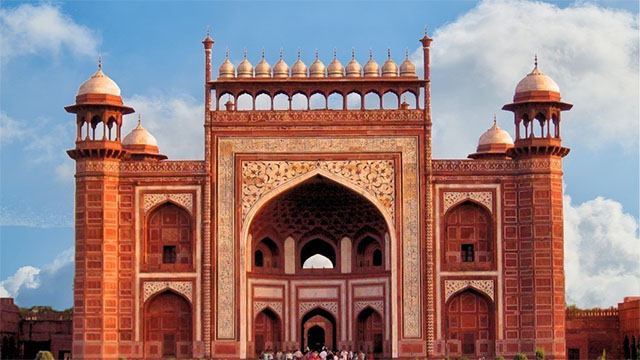
Darwaza E Rauza, or Royal gate, is the main entrance to the Taj Mahal. It does not matter if you enter from East, West, South; all three will lead you towards Royal Gate. This magnificent red and white gate with inlay art has its remarkable value. It gives you a perfect look and shapes the entire Taj Mahal complex.
They used bricks to construct and pasted red stones on them. To beautify it, they carved every stone with flowers and plants. Inlay work on white marble on arches with Quranic verses look stunning. Imagine! How tough it was without the machine as they all did with hands.
Apart from this, The shape of the gate is rectangular. The length is around 41 meters, and the width is 34 meters. Apart from this, the height of the gate is 25 meters.
On every corner, there are four cupolas. Interestingly, On the prominent two arches, there are eleven chapters. Those chhatris you can see inside and outside. Above all, when you enter and see the white marble building, you will feel astonished.
On the left and right of the royal gate, there are (caravan Sarai) pavilions. Those days visitors used to stay here.
FOUR GARDEN (PARADISE PLAN)
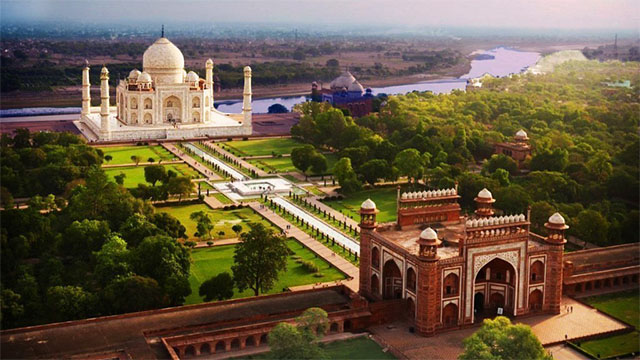
Gardens are an essential part of Mughal architecture. As we already know, they were from Central Asia ( Samarkand). The weather in Samarkand is cold, and on the other hand, In India, it is very hot in summer. Even in the rainy season, there is humidity.
Interestingly, Emperor Babur introduced a four gardens plan in India. A four garden with four water canals means a garden of paradise. Surprisingly, In Quran, there is a description of heaven; they followed it to build these gardens. Moreover, there is a vast garden from the Royal Gate to the Main white monument. It is divided into four parts. There are four water canals with an enormous white platform in the centre. These water canals divide the whole green garden into four parts.
The size of the garden of the Taj Mahal is 300 X 300 meters, and it means from North to South is it 300 meters and East to West also 300 meters. Interestingly, there are many trees with fountains to make it more beautiful. For water supply, they connected all canals with the river.
There is a white marble platform in the garden’s centre with a water tank and fountain. Undoubtedly, it is the best place to capture the beauty of the Taj Mahal by cameras. Apart from this, two buildings are on the left and right of this platform called Jal mahal. Earlier, there may have been a flowing water system. On the left, they have converted into a Taj Museum. It would help if you visited it because there are many valuable things.
MAIN MONUMENT
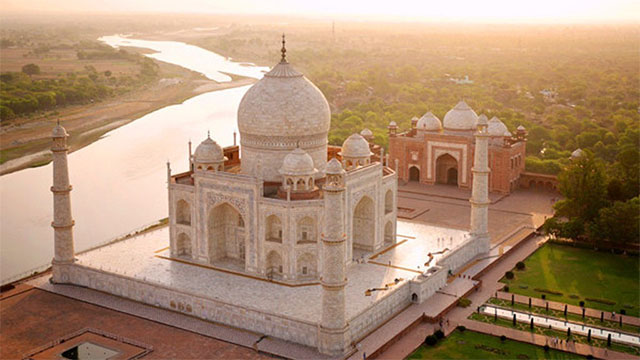
Undoubtedly, this white structure is the main attraction of the Taj Mahal. After crossing the beautiful four gardens, you will reach the central mausoleum. There is a white building in the centre with beautiful work inside and outside. Interestingly, one mosque on the left, Nakkar khana (guest house on the right give it a complete look. Apart from this, the river Yamuna flows behind the Taj Mahal.
EXTERIOR: Now, let us talk about the white monument in detail. I have divided it into two parts Exterior and Interior. Moreover, the total height of the Taj is 73 meters. Surprisingly, the Taj Mahal is around one meter taller than Delhi Sultanate’s Qutub minar. I have divided the exterior into three parts.
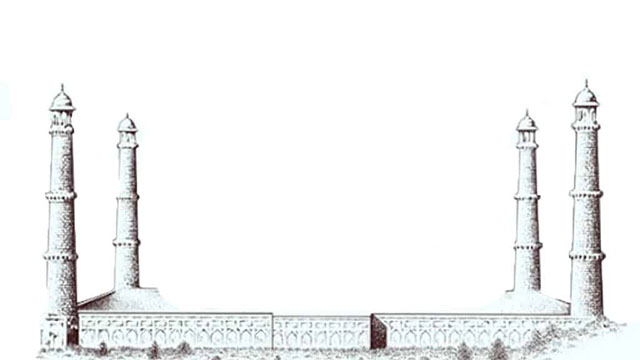
(I) PLATFORM AND MINARETS: Here, we should understand that they built almost every Mughal tomb on a platform. Undoubtedly, the Taj Mahal has the most beautiful platform or plinth. If I talk about white platform size, it is around 95 sq meters, and the height is 23 feet.
Apart from this, there are four minarets at every corner. Interestingly, the height of each minaret is 46 meters, and it is 50 meters high from the river on the riverside.
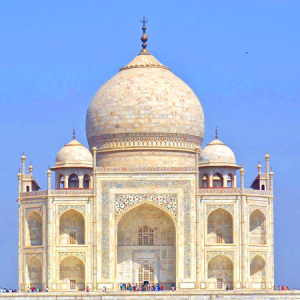 (II) CENTRAL STRUCTURE: There is a substantial central hall structure in the centre of the white platform (plinth). Interestingly, the shape of the hall is octagonal. There are four big arches on every side, beautified with precious stones and semi-precious stones. They used inlay art (flowers) and Quran verses to decorate these arches. Apart from this, there are twenty-four small arches also.
(II) CENTRAL STRUCTURE: There is a substantial central hall structure in the centre of the white platform (plinth). Interestingly, the shape of the hall is octagonal. There are four big arches on every side, beautified with precious stones and semi-precious stones. They used inlay art (flowers) and Quran verses to decorate these arches. Apart from this, there are twenty-four small arches also.
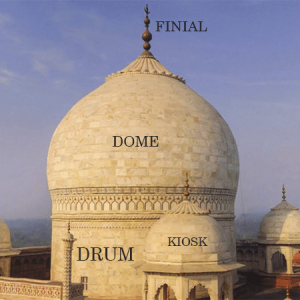 (III) DOME: The beautiful onion dome with a drum (round neck below the dome) enhances the beauty of this marvel—the weight of the dome is 12000 tons. If I talk about the size of the dome then, it is 213 feet high, and the diameter is 58 feet. Interestingly, it is surrounded by four small white chattris.
(III) DOME: The beautiful onion dome with a drum (round neck below the dome) enhances the beauty of this marvel—the weight of the dome is 12000 tons. If I talk about the size of the dome then, it is 213 feet high, and the diameter is 58 feet. Interestingly, it is surrounded by four small white chattris.
Again they used inlay art with semi-precious and precious stones to decorate it. On the top, of the Taj Mahal there is a pinnacle also.Let us talk about the interior and decoration of stones. Undoubtedly, the Taj mahal from inside is more beautiful.
INTERIOR: When you enter the inside, it will be more beautiful. The central hall inside is so amazing. Surprisingly, the inlay work is tremendous. There are many precious stones. For example, Coral, Ruby, Malachite, Turquoise, Lapiz lazuli etc. Let us talk in detail.
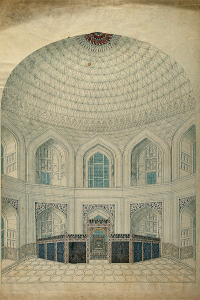 (I) Central Hall: The central hall inside is octagonal, and there are four big windows Jali on every side. Interestingly, it is a two-story structure. To beautify it, they used calligraphy, inlay art and marble windows. The height of the inner dome is 80 feet, and the motifs and inlay work is more beautiful than the outside. Four small octagonal halls of white marble surround the central hall.
(I) Central Hall: The central hall inside is octagonal, and there are four big windows Jali on every side. Interestingly, it is a two-story structure. To beautify it, they used calligraphy, inlay art and marble windows. The height of the inner dome is 80 feet, and the motifs and inlay work is more beautiful than the outside. Four small octagonal halls of white marble surround the central hall.
Apart from this the white floor is fantastic and looks so beautiful. You can see stars designs with black marble to make it more attractive.
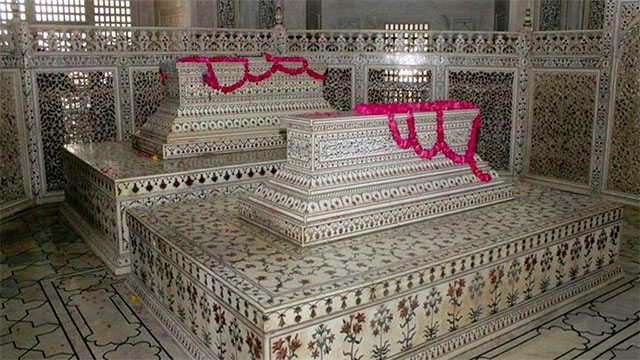
(II) GRAVES: Generally, in the centre, there is always King’s grave. Contrarily, You will find the Queen grave in the Taj Mahal in the centre. Undoubtedly, initially, they built it for Mumtaz Mahal. Emperor Shahjahan died in 1666, and his daughter Jahanara buried him next to Mumtaz mahal. King’s grave is higher than Queen’s.
(III) JALI: Moreover, you will see the most beautiful stonework on the graves. They carved small stones and pasted them on white marble, and artists used Quran verses on graves. It is also surrounded by white marble jalis, the most beautiful work, along with pietra dura inside the Taj Mahal.
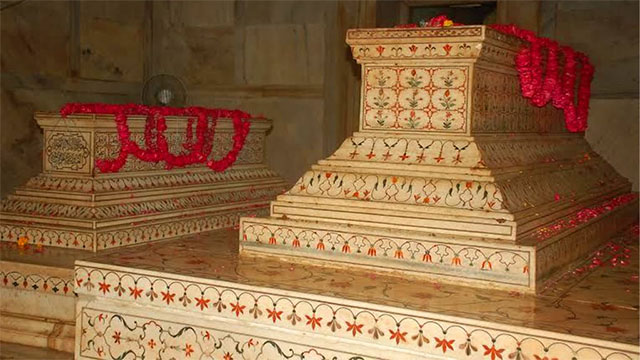
(IV) ORIGINAL GRAVES: Mughals always made two graves. Actual graves are always for the royal family and replica for the public. Interestingly, just below the replica graves, there is an inner chamber. In this room, there are original graves of King and Queen
JAMA MASJID AND NAKKAR KHANA
They always built a mosque near a tomb, and Kings have been following this rule for centuries. There is also a beautiful mosque inside the complex. The Friday mosque is located on the west of the central mausoleum.
Interestingly, The three domes mosque of the Taj Mahal has three arches with one substantial central arch. There is not any minarets but two cupolas on the left and right. They used a red sandstone with white marble.
The most beautiful thing to watch inside the mosque is white paintings inside. Apart from this, there is calligraphy on the central arch and inlay work on the same.
Moreover, the mosque’s size is 60 meters long and 30 meters wide. Outside there is a massive courtyard with a water tank.

NAKKAR KHANA : To give the symmetrical balance, they built a structure on the east side of the mausoleum. Undoubtedly, the design and architecture are the same. The Mughals used Nakkar Khana as a Royal guest house.
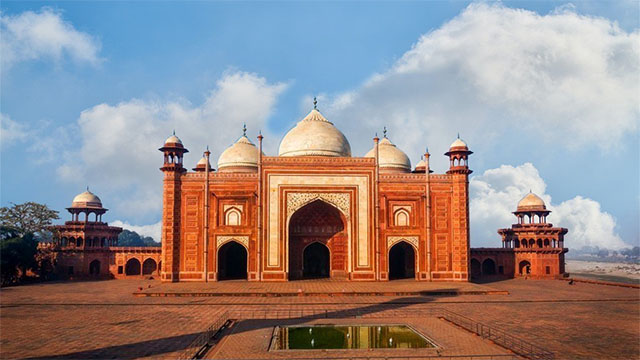
LOVE STORY OF KING AND QUEEN

Prince Khurram later, Shahab Uddin Muhammad Shahjahan, was born in 1592. During that Mughal empire was advancing towards south India. Interestingly he was fearless and intelligent. Emperor Jahangir was very fond of him and made him Governor of Dakkin (south).
Anjuman Bano Begum: This beautiful lady was born in 1593. She was not an ordinary woman, instead of from the Noble family. Interestingly, Asaf Khan’s daughter, who held a high post in the Mughal empire. Moreover, She was the niece of Nur Jahan, who was the wife and Queen of Emperor Jahangir.
TWO SOULS MEET AT MEENA BAZAR: Inside the Agra fort, there was a Shopping bazaar for Royal ladies. Surprisingly, in 1607 Prince Khurram first saw his love Anjumand Bano Begum. She was only 14 years, and he was 15 years old. They fell in love with each other. Who would know they were going to write history in the form of the Taj Mahal.
MARRIAGE OF KING AND QUEEN: Their dream came true; In 1612, they got married. The love between them reached its climax. Surprisingly, Emperor Jahangir died in 1628, and Prince Khurram became King of Hindustan. He took the title of Shahjahan (king of the world) and gave her love the title of Mumtaz Mahal (Pearl of Palace).
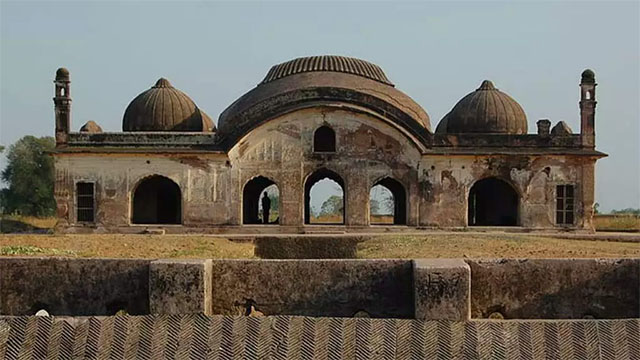
DEATH OF QUEEN: Emperor Shahjahan expanded the Mughal empire into South India. He always took his favorite wife along with him. Sadly, In 1631 he faces the biggest tragedy of his life. Mumtaz Mahal died due to excessive blood loss while giving birth to her 14th child. When Shahjahan came to know sky fell into him. Moreover, they buried her at Burhanpur temporarily, where she died.
STARTING BUILDING TAJ MAHAL: Now engineering skills come into the picture. They initially wanted to build her tomb at Burhanpur, but they could not because the soil was not strong enough to support the structure. Finally, They chose Agra, where the Yamuna makes a sharp curve. Emperor Shahjahan himself planned all things and hired the world’s best talent. Work started in 1631 and finished in 1653.
AURANGZEB REBELLION AND SHAHJAHAN DEATH: Mughal history changed when Prince Muhi Uddin (later Emperor Aurangzeb) did rebellion against Emperor Shahjahan in 1658. Sadly, Emperor Shajahan lost the Mughal throne, and Aurangzeb started ruling. Shahjahan and his daughter Jahanara were not allowed to go outside the fort. Sadly this beautiful soul said goodbye to the world in 1666 at Agra fort while watching the Taj Mahal from Musam mam Burj.
BEAUTIFUL ART OF TAJ MAHAL
Undoubtedly, the world’s best workers and planners build the Taj Mahal. There are many unique features, which make it different from any other monument. Let us talk in detail.
INLAY ART (PIETRA DURA)
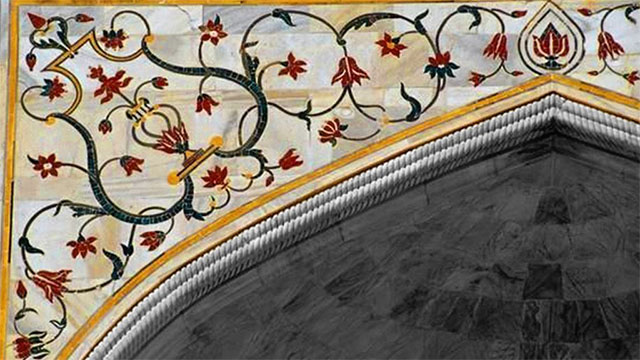
Inlay art (Pietra dura) is where artists carve and paste beautiful stone on the empty carved place. Interestingly, it is the main feature of the Taj Mahal. They made flowers and geometrical designs on white marble. Surprisingly, it looks like paintings, but they are stone. Let us know how they do it.
CARVING WHITE MARBLE: First, they take a substantial white marble slab, then design it with a marker. Finally, with iron tools, they carve it carefully.
CUTTING PRECIOUS STONE COLORFUL: Second, they cut semi-precious and precious stones by hand and make flowers and other patterns.
PASTED PRECIOUS STONE ON WHITE CARVED MARBLE: Lastly, they pasted these stones on white craved marble and finished it.
MOTIFS
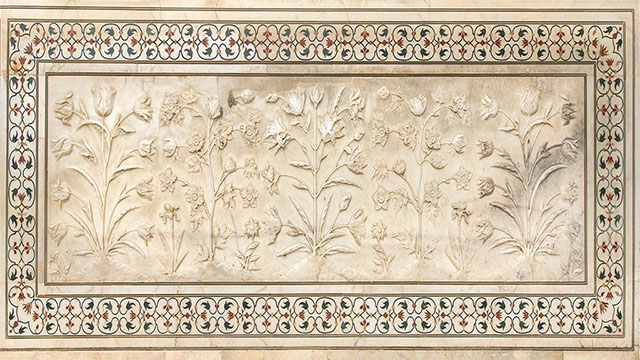
These huge and one-piece white marble slab has a floral design on them. Interestingly, those flowers were available during the Mughal era. These motifs have Pietra dura work on every side of the border, and you can find them at the bottom of the walls.
The most important thing is how beautifully they carved each big slab of white marble, and it is the best example of the artistic work of India.
JALI WORK
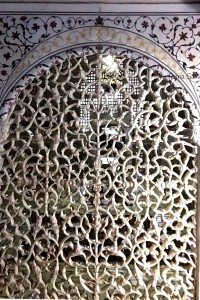 These white marble jalis surround the main tomb inside. Surprisingly, they carved one big slab of white marble and made flowers. Apart from this, they did inlay art on the top and border (Pietra dura). Undoubtedly, it is the most beautiful work in the Taj Mahal.
These white marble jalis surround the main tomb inside. Surprisingly, they carved one big slab of white marble and made flowers. Apart from this, they did inlay art on the top and border (Pietra dura). Undoubtedly, it is the most beautiful work in the Taj Mahal.
Importantly, they carved beautiful flowers on it. Imagine how tough it was with hands. The Pietra dura work again is most beautiful among any other job. They made colorful flowers on the jalis.
CALLIGRAPHY
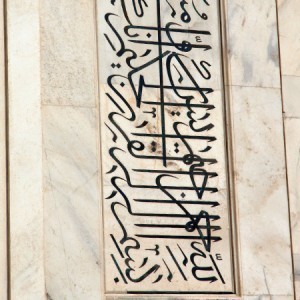
The main feature of any Islamic building is calligraphy.
Usually, they write Arabic on it. Amanat Khan of Persia was chief of calligraphic design of the Taj Mahal.
Interestingly, On the royal gate, you can see Quranic verses. It is not painting; they carved white marble then pasted black marble.
Moreover, On the Main white building, there is calligraphy on every big arch ( there are four arches). They have written the whole chapter of the Quran. Surah Al-Fajr ( THE DAWN ) 89th chapter of Glorious Quran.
MOSQUE PAINTINGS
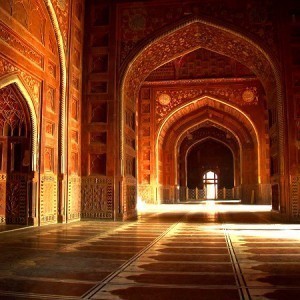
Jama masjid of Taj Mahal is very different from other mosques. Indeed, they used white marble and red sandstone. The most important thing is here they beautified the whole mosque with white paintings.
When you enter, you will realize how beautiful it looks. Interestingly, it is also a place for women to capture the signature pose of the Taj Mahal. Importantly, they made flowers with natural white colors and used motifs.
STONES USED IN TAJ MAHAL
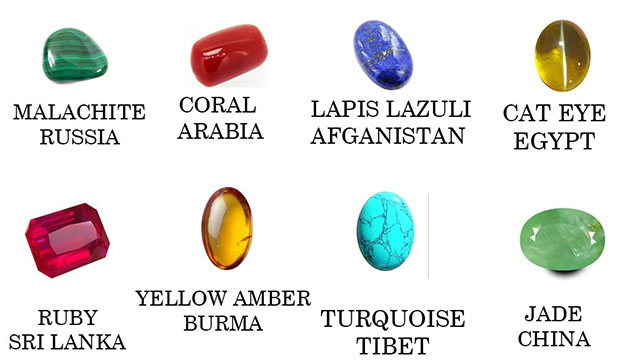
In this image, you can see from where they imported precious and semi-precious stones around the globe.
Apart from this, they imported White marble from Rajasthan (Makrana). Black marble, red sandstone, and yellow stone from Rajasthan.
WHO BUILT TAJ MAHAL?
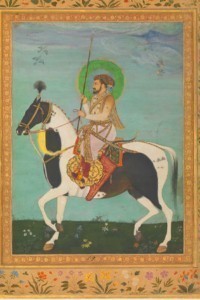
Emperor Shahjahan: Shahab Uddin Muhammad Khurram ( Shahjahan) was born in 1592 in Lahore. He was the most intelligent and brave son of Emperor Jahangir. After the death of his father Jahangir, he ascended the Mughal throne and took the title of Shahjahan in 1628. Interestingly, his mother’s name was Manavati bai; she was from the Rathore clan of Rajput.
Shahjahan got married to his love; he conquered south India in those days. Unfortunately, she died there, and he decided to build her tomb. He also transferred his capital from Agra to Delhi and built Shahjahanabad (OLD DELHI). Surprisingly, Aurangzeb rebelled against him and took the Mughal throne from him in 1658. As a result, he spent his last years in Agra fort, where he died seeing the Taj Mahal in 1666.
Emperor Shahjahan was a master builder. Interestingly, historians call his period as “Golden age of Indian architecture. He not only built a beautiful Taj Mahal but many places also. For example, Old Delhi, Jama Masjid Delhi, Agra, Red fort Delhi, many gardens in Kashmir, many palaces were converted into white marble, etc.
ARCHITECTURE OF TAJ MAHAL
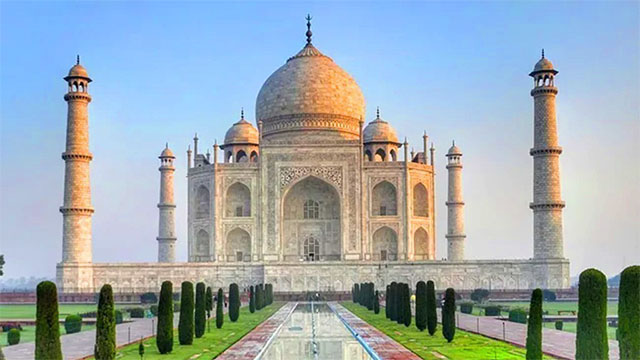
ARCHITECTURE: Taj Mahal is an excellent example of India’s Indo Islamic and Persian architecture. Interestingly, it is also a perfect example of the collaborative work of Indian and foreign artists. Undoubtedly, Emperor Shahjahan hired the best architects, planners, and artists from all over the globe.
ARCHITECT: There was always a debate about the chief architect of this beautiful building. Finally, historians concluded that it was Emperor Shahjahan who himself supervised all of the architects.
Interestingly, Isa Muhammad Khan, under the guidance of Ustad Isa Khan, was the architect. Moreover, Amanat Khan of Persia supervised Calligraphy art and goldwork under Qazim Khan of Lahore.
They started it in 1631 and took 22 years. After working so hard, they finished it in 1654. Surprisingly, 22000 workers completed all of this.
FOUNDATION
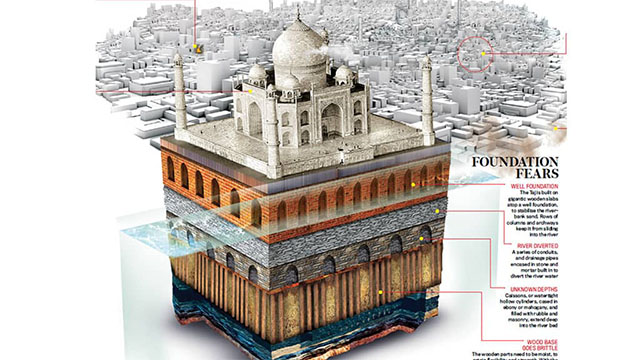
FOUNDATION: There should always be a solid foundation to build a great and gigantic structure beneath the earth. Surprisingly, they used different materials at every stage of the foundation. For example, there are arched structures, bricks platform, rubble, following wells, tight water mortar, and teak woods.
ARCHES AND PIERS: The first stage of the foundation is decisive. There are arches and piers to support the structure’s weight.
BRICK MASONRY: The second stage is brick masonry (platform). Artists built it to provide a vast and robust base.
RUBBLE MASONRY: Interestingly, they used rubble and created another thick base just after brick.
STONE IN LIME: Lime is always beneficial to join stones. There is lime and rocks on this level to make them a strong bond.
SOIL AND WELL: Surprisingly, these wells support the weight of all things. To make it stronger, they used lime and stones also.
TEAK AND BAMBOO WOOD: Lastly, they used these woods to reduce the river’s scouring.
PLAN OF TAJ MAHAL
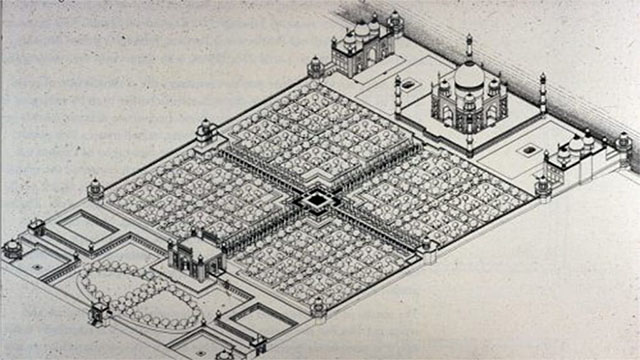
Plan of Taj Mahal: This image will help you understand the whole plan of the Taj Mahal. Shahjahan used his best architectural skills to build this structure. Under the guidance of Ustad Isa Khan, Isa Muhammad Khan helped him finalize this plan.
1. There are three entrances with one Royal gate.
2. There are four gardens with four water canals and fountains. Interestingly, all were connected to the river Yamuna.
3. Mian white buildings as a tomb of Mumtaz Mahal. On the left is a mosque; on the right, nakkar khana (guest house).
PLAN OF WHITE BUILDING HALL

This image will help you understand the plan of the central hall structure of the white building. Indeed, the design is octagonal, from the outside and inside. On the top of this structure, there is a dome.
Interestingly, the hall inside is surrounded by four small octagonal rooms. I can say that the work inside they have done is more worth than outside.
FACTS OF TAJ MAHAL
It took a long twenty-two years to construct this universal symbol of love.
A total of 22000 workers participated in completing this task.
Emperor Shahjahan himself supervised all the things. Including design and hiring talent.
It is the first wonder of the world, and Tourists, couples, lovers come here from around the globe to immerse themselves in the beauty of the Taj Mahal.
They imported all precious stones and used the marble of India.
The total weight of the central white dome is 12000 tons.
Seventy-three meters is the full height of the Taj Mahal.
Black Taj was a myth; he did not plan to build it.
PLACES NEAR TAJ MAHAL
Agra fort: Agra fort is very near to the Taj Mahal. This historical fort has many things to watch.
Itmad Ud Daula: Baby taj is very famous for its art and white marble beauty. It is located on the other bank of river Yamuna.
Mehtab Bagh: The moonlight garden is located across the river, and it is the first Mughal pleasure garden.
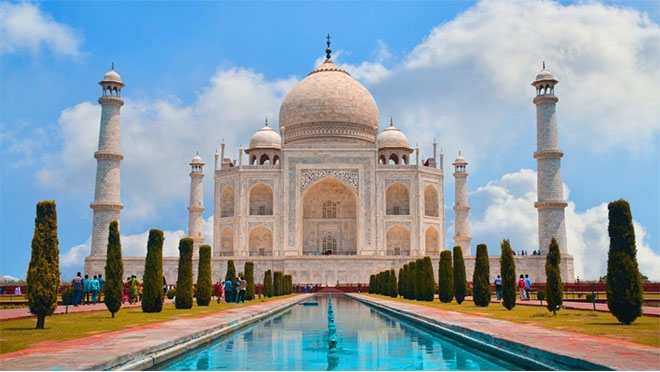
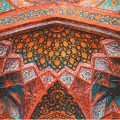
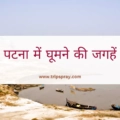

2 Comments